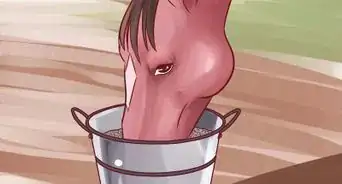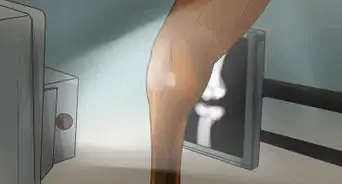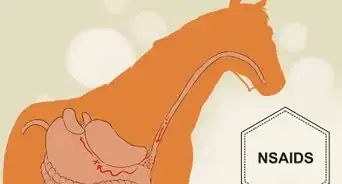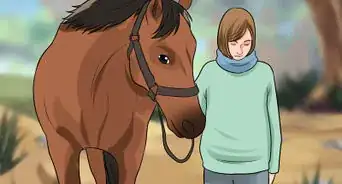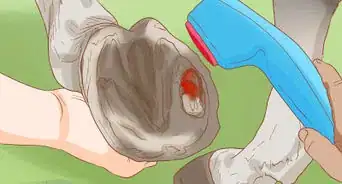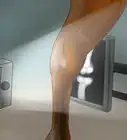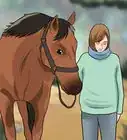This article was co-authored by Pippa Elliott, MRCVS. Dr. Elliott, BVMS, MRCVS is a veterinarian with over 30 years of experience in veterinary surgery and companion animal practice. She graduated from the University of Glasgow in 1987 with a degree in veterinary medicine and surgery. She has worked at the same animal clinic in her hometown for over 20 years.
wikiHow marks an article as reader-approved once it receives enough positive feedback. This article received 12 testimonials and 95% of readers who voted found it helpful, earning it our reader-approved status.
This article has been viewed 277,323 times.
If you notice your horse is not his normal self or is walking oddly, you may need to have him checked for laminitis. This disease can strike any horse at any age, and you should watch for the signs. If you don't know the symptoms or what is done to treat laminitis, this article will help you identify the symptoms in your horse.
Steps
Recognizing Laminitis or Founder
-
1Understand what Laminitis is. Laminitis is a disease that causes lameness in horses. It was once associated primarily with overweight ponies, but it can affect any age or size of horse.
- With this disease, the laminae weaken, which attach the pedal bone to the inside of the hoof. The horses pedal bone detaches from the inside of the hoof. Therefore, the pedal bone can turn, and sometimes, it even pushes through the sole. When it pushes through the sole, it's called "founder."
- This bond is composed of a non-living layer and a sensitive living layer, much like nails and the nail beds. The detachment happens when this layer disconnects.
-
2Look for early signs of laminitis. The early stage of laminitis is called the acute stage. In this stage, the horse has developed laminitis, but the hoof hasn't detached yet.[1]
- Pay attention to your horse's mood. He may seem down, and his appetite may be less than normal.[2]
- He'll try to avoid exercise, as walking will be painful. He also might be standing differently than normal because he is trying to relieve the pain. For instance, he may push his front feet forward to relieve stress.[3]
- Look for changes in walking, such as not being able to turn easily, especially on hard surfaces. Even if he seems fine while walking on soft surfaces, how he acts on hard surfaces can be a dead giveaway.[4] Also, the horse may want to shift from foot to foot all the time.[5]
Advertisement -
3
-
4Check for increased heart rate and respiratory rate. When your horse is entering the early stages of laminitis, his heart and respiratory rate can begin to increase. The heart rate may move up to 60 to 120 beats per minute, while the respiratory rate may move to 80 to 100 breaths per minute.[8]
-
5Check for signs of the subacute stage. The subacute stage of laminitis is when the laminitis has gone past 3 days, but it still hasn't detached. Symptoms are actually less noticeable in this stage, but they are the same as the acute stage, such as increased heart rate and changed walking stance.[9]
-
6Look for changes in the way the horse stands. His feet are painful so he wants to take the weight off them. A typical stance is to rock backwards, putting most of his weight on his heels. This makes the horse look as if he's leaning backwards. It is also difficult to get the horse to move. Having found a relatively comfortable way of standing, he's reluctant to move and cause pain.The chronic stage begins anytime the hoof detaches.[10]
- Watch for the horse wanting to rest. If the horse wants to lay down or rest more often than normal, that can be a sign of a problem. Similarly, if the horse refuses to come out of his stall or is reluctant to walk, that is likely a sign that laminitis has reached the chronic stage.[11]
Treating Laminitis or Founder
-
1Call your vet immediately. Describe in detail what you are observing to your vet. Take your horse's temperature and heart/breathing rates. Every horse owner should have a working stethoscope and rectal thermometer available, and know how to use them.
-
2Do not force your horse to walk or move. If your horse is showing signs of lameness, do not force him to exercise. If he is a significant distance from home, you should transfer him by trailer. Lay down a deep bed of shavings (4 or 5 inches) in his stall. These shavings will provide padding for your horse, helping to relieve some of the pain.
-
3Take some palliative measures while waiting for the vet to arrive. Taking the following measures before your vet arrives will make their job easier and give your horse some much-needed relief.
- Use cold therapy. Cold therapy is much the same as it is in humans.[12] You ice down the horse's feet just as you would an injured knee or ankle in a human. You can either use a muck tub with ice and water or use ice boots to apply the ice to the horse. Do not leave it on for more than 30 minutes.[13]
- Provide an NSAID painkiller. These types of painkillers help relieve pain, of course, but they can also help with inflammation. You can give your horse Equioxx, Danilon, or Phenylbutazone ("Bute"), for instance.[14] These are not to be given if the horse is on steroids, as the two drugs are contra-indicated together and can be a fatal combination. Always speak to your vet before giving any prescription medication to your horse.
- Treatment for laminitis can vary, depending on the severity of the condition, but the mainstay for years is to get your horse started on a regimen of Phenylbutazone, which is a powerful anti-inflammatory. That, along with proper and supportive footing, are two of the treatments used in helping to alleviate the pain/disease.
-
4Allow the veterinarian to diagnose the condition. Your vet will check for the symptoms listed above by examining the horse, though she is better trained to spot the symptoms. Your vet may also want to take x-rays to examine the interior of the hoof.[15]
- Ask how long you should provide anti-inflammatories to your horse. When you are giving your horse some of these drugs, such as Bute, you may need to skip a day after about a week.[16]
-
5Ask about acepromazine. This drug can increase blood flow to the laminae, which helps the condition in some cases. It can also sedate your horse to some degree, which will keep him calm and less likely to injure himself further.[17]
-
6Get an orthopaedic farrier (one with an additional qualification in treating conditions like laminitis by corrective shoeing) to assess the horse. They may be able to take some of the pressure off the foot by clever use of special shoes. They can also assess to horse to see if sole-pads are appropriate. Be cautious about applying any measures yourself because if you get it wrong you could tip the angle of the hoof and possibly precipitate the pedal bone punching through the sole of the hoof.[18]
- You can cut a piece of thick foam to the size of the hoof. It should be a couple of inches thick to provide padding for the horse.[19]
-
7Investigate the possible causes of the disease to prevent it from occurring again. Laminitis is sometimes caused by a horse being overweight and eating fresh pasture but not always. Other diseases can bring on bouts of laminitis. Research is still on-going concerning this disease, as its mechanisms and best modes of treatment and prevention are still not fully understood.[20]
- One important test when looking for the cause is to test the blood sugar level of the horse, as too much sugar in the system is one risk factor for this disease.[21]
Preventing Laminitis
-
1Don't feed too much starch or sugar. Certain grasses are too sugary for horses, who cannot process the starch. Often, grass in spring and fall is too sugary, as well as grass that was grown particularly for cattle. Though experts are still unsure as to why, this overabundance of starch in the horse's body can lead to laminitis.[22]
- Avoid feeding your horse on cattle pasture, and also avoid putting your horse to pasture soon after a frost. In addition, closely grazed grass can result in pasture that is too sugar-rich for your horse.
-
2Limit cereal consumption. Though horses can eat some cereal in their feeds, try to avoid feeding too much. You should especially limit cereals rich in molasses. Similar to overly sugary grass, too much grain can cause excess starch in the body, leading to laminitis.
- Don't feed more than 3 to 4 pounds of cereal to your horse at one time.
-
3Watch for signs of laminitis after infection. Infection in another part of the body can also lead to laminitis. For instance, a horse that doesn't deliver all the afterbirth may develop an infection. In turn, that horse can develop laminitis.
- Other sicknesses can lead to laminitis, too, such as Cushing's Disease. Be on the lookout for laminitis if your horse has Cushing's.
-
4Look for laminitis after giving corticosteroids. If your horse recently had a round of steroids, make sure to be on the lookout for the symptoms of laminitis. You should particularly pay attention when your horse has had a very large dose of steroids.
- Please note, steroids and bute must not be given together; it can be fatal. If you horse develops post-steroid laminitis, always speak to your vet before giving bute to relieve the pain.
-
5Keep horses from racing on hard ground. Another factor that can lead to laminitis is working horses too strenuously on hard ground, such as concrete. In addition, horses who are overweight can suffer from laminitis, as the extra weight adds pressure to the hooves.[23]
-
6Keep your horse's hooves trimmed. If you don't keep your horse's hooves trimmed, it can place excessive pressure on the hooves. That pressure can damage the laminae, which in turn can lead to laminitis.
- Hire a local farrier to keep your horse's hooves trimmed. In addition to keeping the hooves trimmed, the farrier will know what to look for with laminitis, so he or she may catch it earlier than you.
Warnings
- Though you may hear varying opinions from other horse owners or trainers, do not wait to get your vet involved. The sooner the problem is treated, the better chance of a positive outcome.⧼thumbs_response⧽
- If your horse ever gets to where it can't stand up or if the coffin bone drops through the sole of the hoof you must put your horse down.⧼thumbs_response⧽
- Don't feed your horse Alfalfa Hay or other starchy hay. Alfalfa Hay is loaded with starch. Alfalfa Hay will cause your horse to get laminitis.⧼thumbs_response⧽
References
- ↑ http://www.merckvetmanual.com/mvm/musculoskeletal_system/lameness_in_horses/laminitis_in_horses.html#v3284417
- ↑ http://www.merckvetmanual.com/mvm/musculoskeletal_system/lameness_in_horses/laminitis_in_horses.html#v3284417
- ↑ http://www.merckvetmanual.com/mvm/musculoskeletal_system/lameness_in_horses/laminitis_in_horses.html#v3284417
- ↑ http://www.thelaminitissite.org/laminitis.html
- ↑ http://www.merckvetmanual.com/mvm/musculoskeletal_system/lameness_in_horses/laminitis_in_horses.html#v3284417
- ↑ http://www.thelaminitissite.org/laminitis.html
- ↑ http://www.merckvetmanual.com/mvm/musculoskeletal_system/lameness_in_horses/laminitis_in_horses.html#v3284417
- ↑ http://www.merckvetmanual.com/mvm/musculoskeletal_system/lameness_in_horses/laminitis_in_horses.html#v3284417
- ↑ http://www.merckvetmanual.com/mvm/musculoskeletal_system/lameness_in_horses/laminitis_in_horses.html#v3284417
- ↑ http://www.merckvetmanual.com/mvm/musculoskeletal_system/lameness_in_horses/laminitis_in_horses.html#v3284417
- ↑ http://www.thelaminitissite.org/laminitis.html
- ↑ http://www.merckvetmanual.com/mvm/musculoskeletal_system/lameness_in_horses/laminitis_in_horses.html#v3284417
- ↑ http://www.chronofhorse.com/article/ice-down-ride
- ↑ http://www.thelaminitissite.org/laminitis.html
- ↑ http://www.merckvetmanual.com/mvm/musculoskeletal_system/lameness_in_horses/laminitis_in_horses.html#v3284417
- ↑ http://www.merckvetmanual.com/mvm/musculoskeletal_system/lameness_in_horses/laminitis_in_horses.html#v3284417
- ↑ http://www.merckvetmanual.com/mvm/musculoskeletal_system/lameness_in_horses/laminitis_in_horses.html#v3284417
- ↑ http://www.merckvetmanual.com/mvm/musculoskeletal_system/lameness_in_horses/laminitis_in_horses.html#v3284417
- ↑ http://www.merckvetmanual.com/mvm/musculoskeletal_system/lameness_in_horses/laminitis_in_horses.html#v3284417
- ↑ http://www.thelaminitissite.org/laminitis.html
- ↑ http://www.thelaminitissite.org/laminitis.html
- ↑ http://www.laminitis.org/laminitis.html
- ↑ http://www.laminitis.org/laminitis.html
About This Article
To recognize and treat laminitis in a horse, start by looking out for the initial signs of laminitis, which include loss of appetite and pain while walking. You might also see your horse pushing its feet forward to relieve the pain while standing. Additionally, check to see if your horse has flaky hooves or odd shaped rings on them. Once you’ve detected these symptoms, contact your veterinarian immediately. While you wait on the vet, apply ice to your horse’s feet to relieve pain. For tips on how to ask your vet about medication and how to prevent the disease from recurring, read on!
-in-Horses-Step-1-Version-3.webp)
-in-Horses-Step-2-Version-3.webp)
-in-Horses-Step-3-Version-3.webp)
-in-Horses-Step-4-Version-3.webp)
-in-Horses-Step-5-Version-3.webp)
-in-Horses-Step-6-Version-3.webp)
-in-Horses-Step-7-Version-3.webp)
-in-Horses-Step-8-Version-2.webp)
-in-Horses-Step-9-Version-2.webp)
-in-Horses-Step-10-Version-2.webp)
-in-Horses-Step-11-Version-2.webp)
-in-Horses-Step-12-Version-2.webp)
-in-Horses-Step-13-Version-2.webp)
-in-Horses-Step-14-Version-2.webp)
-in-Horses-Step-15-Version-2.webp)
-in-Horses-Step-16-Version-2.webp)
-in-Horses-Step-17-Version-2.webp)
-in-Horses-Step-18-Version-2.webp)
-in-Horses-Step-19-Version-2.webp)
